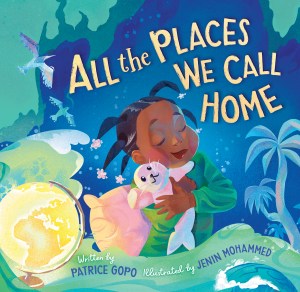Meet Patrice Gopo
 Patrice Gopo is the child of Jamaican immigrants and was born and raised in Anchorage, Alaska. She is an award-winning essayist and the author of All the Colors We Will See: Reflections on Barriers, Brokenness, and Finding Our Way (a Fall 2018 Barnes & Noble Discover Great New Writers selection). Her ties to Jamaica and other parts of the world sparked her early desire to travel to the cities and countries she traced on a globe. In time, as she began writing about her experiences, Patrice became interested in how places contribute to the people we become. Ultimately, she hopes her stories celebrate the beauty of living a multifaceted life. Patrice lives with her family in North Carolina—a place she considers another home. All the Places We Call Home is her first picture book.
Patrice Gopo is the child of Jamaican immigrants and was born and raised in Anchorage, Alaska. She is an award-winning essayist and the author of All the Colors We Will See: Reflections on Barriers, Brokenness, and Finding Our Way (a Fall 2018 Barnes & Noble Discover Great New Writers selection). Her ties to Jamaica and other parts of the world sparked her early desire to travel to the cities and countries she traced on a globe. In time, as she began writing about her experiences, Patrice became interested in how places contribute to the people we become. Ultimately, she hopes her stories celebrate the beauty of living a multifaceted life. Patrice lives with her family in North Carolina—a place she considers another home. All the Places We Call Home is her first picture book.
You’re an established writer, having already written a book and essays. What made you want to write a children’s book?
I wrote a picture book because I love picture books! I love picture books because they help children imagine the world not just as it is but also as what it could be. These stories tap into qualities we long to see in abundance—such as kindness and compassion. Even the books that cover challenging topics hold sparks of something greater.
I specifically wrote All the Places We Call Home because I wanted to illuminate how family stories of far-off lands help shape children, help form their identity, and help connect them with their broader world. Ultimately, All the Places We Call Home celebrates the beauty of living a multifaceted life. I return repeatedly to this theme in all of my writing. I wanted to share that truth with children.
All the Places We Call Home explores identity formation. Why do you think it’s important to begin that discussion at a young age?
All the Places We Call Home is a window into an experience many children live. Our world is one where movement across state and country borders is part of the reality for many families—and the children growing up in those families. These children may consider their home to be where they take an afternoon nap. However, they can also recognize their connection to distant places they may rarely visit and people they may rarely see—places and people that contribute to the formation of their unique cultural identity.
We must speak to our children about identity formation from an early age because this act helps them begin to recognize themselves as being complex human beings. And they also begin to recognize other people as being complex human beings. We are each comprised of many stories and experiences. As a society, we must seek to honor those realities in ourselves and our children’s lives.
You’re no stranger to tackling meaningful and complex topics. How did you approach this differently with it being a children’s book?
I love this question because All the Places We Call Home is based on essay called “Before” in my collection, All the Colors We Will See. Years ago, in rural Zimbabwe, my oldest daughter took a nap on her great-grandmother’s bed. That day I remembered a childhood nap I had once taken on my grandmother’s bed in rural Jamaica. I recognized how my daughter’s story would, in many ways, mirror my story: a child who lives in one place but has cultural ties to other parts of the world. That experience became the essay “Before.”
When I initially started writing All the Places We Call Home, I attempted to take “Before” and pare it down, still clinging to the complex language and structural movement. That draft failed miserably. The failure, however, was still a great learning experience. I discovered I needed a different approach for a picture book versus the meandering approach I often take when writing essays. With essays, the images and lyrical language usually come first and lead me toward the story. With picture books, I discovered that the story usually comes first and leads me toward the rich imagery and lyrical language.
The illustrations, done by Jenin Mohammed, really bring all of these different places to life. Did you have a vision for what these would look when you began writing the book?

Jenin Mohammed’s illustrations are just phenomenal. The images reflect such movement and genuinely create a feeling of traveling to these different places: an urban area in South Africa and a rural area in Zimbabwe and Jamaica. Gorgeous!!
As the story is so steeped in my family’s life, my only vision was that the story featured a Black mother and daughter. Beyond those details, I hoped the illustrations would reflect a sense of whimsy, wonder, love, joy, and delight—qualities that are part of the story. Of course, there wasn’t a place to communicate such desires since those words are rather vague. However, Jenin’s incredible illustrations still captured all these emotions!!! I was thrilled to realize that Jenin also saw those feelings reflected in my words. The first time I saw the image of the mother and daughter, I started to cry.
Is there a piece of you that’s in the character of the story? Have you always been connected to the people, stories, and places that shape you?
My whole heart is in All the Places We Call Home. I am the child of Jamaican immigrants who was born and raised in Anchorage, Alaska. I married a man from Zimbabwe, and we lived in South Africa for a time. We are now raising our daughters in a household where cultural backgrounds and stories weave together every day—much like the little girl’s experience in the book.
As a child, I rarely visited my parents’ Jamaican homeland. Cost and distance were very real factors. Many children have similar experiences for various reasons, and I wanted to give a subtle nod to this truth in All the Places We Call Home. Despite my family living in Alaska, my parents raised me with a deep sense of connection to Jamaica. As an adult, I am helping to give a similar gift to my children. I hope this story will inspire other families to celebrate the places connected to their story, even if they do not live there—to celebrate the various places they call home.
What is a tangible way for kids (and even their parents) to begin to learn about the people and places they come from, and how can they start connecting with them?
Share stories! Ask questions! Share stories! We can help children engage with the people and places they come from by talking about the people and places they come from. Share origin stories. Share the story of how their family came to live in the place they live now. Share stories about moving from one place to another. Or share stories about remaining in one place. Along the way, encourage children to ask questions about their story and their family’s story.
In addition, I’ve created a fun and simple activity called “A Place I Call Home?” that you can download. Children and adults can consider the places that matter to them and create poems about those places!
People love to learn about what goes into writing a book. What was the writing process like for you?
I think of the writing process as a beautiful combination of generating words and revising those words. However, the most challenging part of my writing process is generating the initial words that will ultimately lead to the final story. The blank page scared me a bit, so I had to trick myself into not having to face the blank page. I do this by writing story fragments—on my phone, in a notebook, on the back of a receipt. Then I eventually compile all those fragments into a messy first draft. Once I have a draft, I’m in my favorite place of being able to revise what I’ve written.
Is there anything specific you hope readers will take away from the book?
As I mentioned earlier, I hope this story will inspire children to recognize themselves and others as complicated human beings—people comprised of many stories and experiences.
I also hope All the Places We Call Home will encourage children and their families and caregivers to embrace this beautiful truth: the places we come from can be part of us, even if we can’t always be near them. Places we’ve never lived—or we no longer live—can deepen our understanding of ourselves. Our children can connect to more than just the place where they fall asleep at night. For some, their ties stretch across the world. For others, they stretch across their town. Ultimately, may this story inspire others to celebrate the various places they call home.
Where can people find you and your previous works?
Please visit my website: www.patricegopo.com
You can also find me on my Facebook page: www.facebook.com/patricegopowrites
You can subscribe to my newsletter here: www.patricegopo.com/subscribe